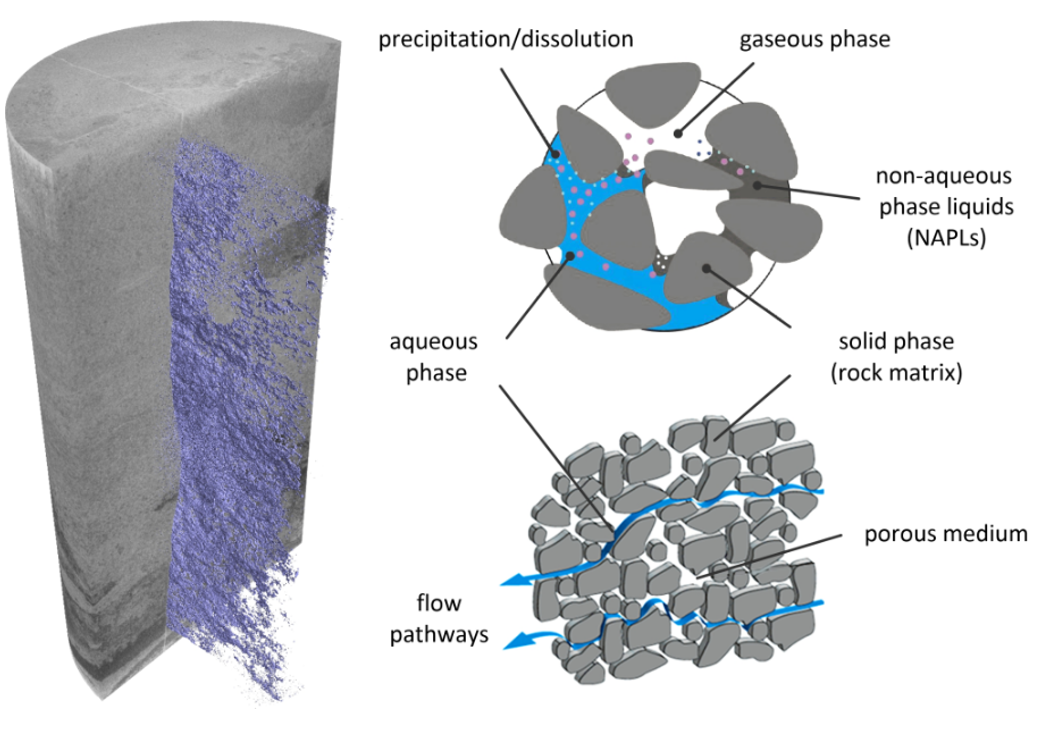Introduction:
Crystal nucleation, precipitation, and growth during a reactive fluid flow and solute transport are critical in a vast range of natural and industrial systems. Mineral growth is a prime example where (geo)chemical reactions give rise to geometry evolution in porous media. The precipitation reactions can reduce porosity, alter pore space connectivity and morphology, modify tortuosity, deteriorate permeability, and change the fluid flow and solute transport.
Additionally, precipitation reshapes the available surface area for growth, leading to changes in the system's reactivity, reaction progress, and reaction rates. Understanding, controlling, and predicting this reactive transport process is complicated because it requires coupling flow, transport, and chemical processes often characterized by different temporal and spatial scales.
Research Objectives:
Motivated by the importance of incorporating stochastic dynamics of nucleation and growth in studying a variety of multiphase and multiscale processes occurring in geo-environmental and geo-energy systems, this research aims to investigate geometry evolution during reactive flow and transport in porous media induced by mineral precipitation.
Research Scope:
For the experimental part of the project, A) mineral surface scale experiments will be conducted using synthetic and natural substrates to evaluate the impact of various surface characteristics under broad physical/chemical conditions. B) three-dimensional micro-plugs will be utilized to evaluate the deterioration of porosity-permeability in porous reservoir rocks (and synthetic idealized porous media) as a result of mineral precipitation and temporal evolution of the system. Identifying underlying physics and governing factors in pore-scale/meso-scale to formulate consequences for macroscale flow and transport is paramount.
For the numerical simulation part of the project, based on the competencies and interests of the candidate, A) direct numerical simulation and B) upscaled numerical models will be used to replicate and further investigate the dynamics and dimensionality of probabilistic nucleation and stochastic growth in porous media. Alternatively, open-source GPU-based LBM packages can be used to investigate the consequences of mineral precipitation (via updating geometries) for single/two-phase flow and solute transport in porous media.
For each part, candidates will have training and responsibilities to develop the necessary tools for carrying out the research (laboratory setup or numerical code), conducting the research to answer open questions, following the overall objectives, and compiling a report/manuscript to present the results and discuss findings.
With active participation and supervisors' directions, the candidates will have an opportunity to be involved in state-of-the-art research, receive training in experimental and modeling techniques, familiarize themselves with reactive transport studies, and be part of a lively curiosity-driven research group. In collaboration with supervisors, the candidates will disseminate the project outcome in a conference proceeding and/or peer-reviewed article. The project will be an opportunity to start learning and working with techniques for studying the fluid flow and reactive transport processes relevant for subsurface storage, geo-energy and hydrocarbon resources, geothermal energy, waste disposal, and environmental studies.
